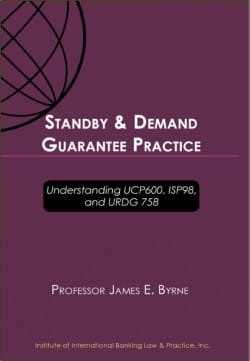DCW Monthly: April 2025
This month, DCW unpacks the legal and practical shifts reshaping trade finance interpretation. Why are ICC Opinions becoming increasingly scarce?
Looking back at Professor James E. Byrne's 6 predictions for LCs in 2012 - see how they hold up.

This article written by IIBLP founder Professor James E. Byrne originally appeared in the September 2012 issue of DCW. We're featuring it anew in 2024 to consider alongside the LC Trends collection.
Compared to 20 years ago, the LC landscape has changed dramatically. From a staid device whose most serious controversies turned on how many days were a reasonable time, it has evolved into a highly complex and rapidly evolving device. No longer can a bank executive assume that the area will continue to function without attention. This article identifies six trends that affect its continued value and profitability and suggests proactive steps to respond to them.
Instead of getting simpler and more reliable, commercial (so-called “documentary”) letters of credit have become byzantine in their complexity. Twenty years ago, a banker would study UCP400 (1983 revision), might consider an infrequent opinion of the ICC Banking Commission, and would almost never consult a lawyer. Not today. Today’s banker must be armed with UCP600 (2007), the International Standard Banking Practice (2007 Revision) (now undergoing extensive overhaul again), detailed opinions by the ICC Banking Commission, and decisions by DOCDEX (an ICC mediation service) – not to mention court decisions. Unlike 20 years ago when variations of the UCP were relatively rare, today’s credits regularly make modifications or exclusions to UCP600, many of which contain provisions not readily understood or interpreted.
Despite an exponential increase in rules, interpretations, and decisions, there has been no appreciable decrease in the number of discrepancies. Indeed, the reputation of the commercial LC has suffered if the dropping proportion of its use to total transactions is any indication as the increase in open account transactions or use of other forms of assurance for payment demonstrates.
At a time when transport is increasingly multimodal, the conceptual framework of the rules, bankers, and business people remain fixated on the paradigm of an on board order maritime transport document.
It scarcely takes a crystal ball to observe a trend toward “electrification” of the LC or at least LC processing.
Indeed, the problem has been that there has often been too much overbroad predicting and too little electrifying.
When UCP400 was drafted in the early 1980s, a paperless era was declared to be not only inevitable but imminent. When people talk about “paperless” in the sense of LCs, it has long meant “incoming” (to the issuer) rather than “outgoing” (from the issuer). The outgoing portion has been dematerialized since the telegraph became a regular tool of business and that process has culminated in the masterpiece that is the SWIFT system. It is the electrification of the incoming portions that has been awkward, messy, and resistant to change.
The years since UCP400 (1983) have been marked (one might even say littered) with the attempts to achieve the electrification of the incoming process. CBOL, Bolero, and the efforts of various manufacturers groups are but a few.
In the time leading up to when eUCP entered into force at 24:00 hours on 31 March 2002 and many minutes thereafter, many pundits thought that this electronic supplement to the UCP would usher in an era in which the paperless credit was the industry norm. Some even predicted it would further accelerate the demise of the traditional LC. These expectations have fallen woefully short. How many credits issued subject to eUCP that actually triggered electronic presentation have you seen?
The electrification strategies have varied, as well: Tackle the bill of lading; focus on standby/demand guarantees; permit “mixed presentation”; move toward open accounts (by-passing the LC); re-intermediate the role of banks with a “super-invoice”; and so the list goes on with energy, money, and enthusiasm poured out.
This long line of less-than-complete successes, however, should not obscure the slow but steady reality that there has been creeping electrification of the incoming process. Advancement and innovation of electronic means will therefore continue, albeit at an uneven pace. Great strides have been made to electronify portions of the LC process and documentation. There is no going back. Countless documents are scanned every hour and electronically “shipped” to the other side of the world for examination. Parties have been unwilling to take in all of eUCP, but have varying levels of comfort and motivations for electronifying certain pieces of the letter of credit process.
In recent months, there have been more frequent instances of bank clients wishing to send documents electronically, but who do not want credits issued subject to eUCP.
Banks can (and do) invest significantly in developing electronic means to attract more business from customers, but corporate LC users what they want, when they want it. Movement is also afoot to launch the BPO (Bank Payment Obligation) which features a data matching scheme in lieu of document presentation. How widespread this initiative will be embraced remains to be seen.
The “trend”, if you will, is that there is continuing and mounting pressure to reduce costs, reduce paperwork, and simplify processing of documents. And while the role of banks in this process can be reduced in some sectors (especially in good times), banks still can provide highly efficient means of financing and intermediation between buyers and sellers and their intermediaries and agents.
Another product of the LC family continues to be beset with difficulties. Some of them are due to their name, “guarantee”, which by its nature refers to a promise that is dependent and not independent. This difficulty can be overcome by careful drafting. However, the forms and the terminology that is commonly used is far from careful. It is drawn from dependent (suretyship/ accessory) guarantee practice and not from letter of credit practice. As a result, every year there are multiple cases in which the courts are forced to decide whether a given undertaking is dependent or independent. In many of these cases, the courts might as well flip a coin because there is no principled basis for a decision.
Other continuing problems remain unresolved, such as whether the termination of the undertaking by its expiration ends the liability of the guarantor or whether it is necessary to retrieve the original operative instrument.
The revision of the Uniform Rules for Demand Guarantees (URDG) (2009 revision) was intended to resolve many of these issues and to introduce uniformity of practice. What it has done, however, is to leave banks with three or four very different options for demand guarantees and standbys: URDG 458 (1992 version); URDG 758 (2009 revision); UCP600; and ISP98. The differences relate to issuance, examination, presentation, honor or dishonor, and transfer and assignment of proceeds. Since most major banks cannot refuse to use any of these rules, they have to be prepared to work with the differences. They run the serious risk of staff confusion between them.

The three practice rules compared side by side - the ultimate drafting handbook.
Many beneficiaries and bankers have avoided the guarantee problem by urging their customers to use standby letters of credit which are not beset with the same difficulties as demand guarantees, particularly when they are subject to practice rules. The release of the ISP98 Model Forms has addressed many of these problems due to lack of uniformity. These forms which have been featured in recent DCW issues contain standardized terminology and annexed demand for all situations in which a standby can be used (and not just traditional performance situations), automatic extension and reduction clauses, demands for transfer, counter undertakings and local undertakings, and confirmations.
The difficulties with commercial letters of credit have led some beneficiaries who desire the protection of a letter of credit to move to the use of commercial standbys. While demand guarantees can serve this function as well, none of the guarantee rules are apt for such usage. A commercial standby can enable the beneficiary/seller to ship goods to the applicant/buyer without worrying about the intricate UCP600 transport document rules and receive payment directly from the applicant. The standby is available in the event of non-payment within an agreed time (e.g. 30, 60, or 90 days).
There is little problem with these undertakings being subject to UCP600 where all that is required is a simple demand. Where commercial documents or copies of them are required, however, the serious problem arises of examining documents subject to detailed practice rules in a situation where the documents were not prepared for submission under a letter of credit. The result is commonly refusal due to discrepancies.
The movement toward commercial standbys can be facilitated by use of ISP98 which was designed with commercial standbys in mind and which provides that commercial documents will be examined in accordance with the terms of the standby itself and not rules for commercial documents under a commercial letter of credit.
SWIFT’s BPO (Bank Payment Obligation) is a species of a commercial standby intended to be self contained or subject to special rules.
Twenty years ago, embargoes affecting letters of credit were relatively localized. As nation states have become increasingly aware of the central role of economics in achieving policy objectives, they have used the global payments and banking system to wage war, to restrain rogue nations, to prevent the proliferation of nuclear and chemical weapons, to track drug money, and to achieve various other goals.
The impact on letters of credit, standbys, and demand guarantees has been significant. The US has taken the lead in pressing for bank compliance on an extra-territorial basis, imposing heaving fines on banks engaging in off-border dollar transactions in violation of its increasing intrusive regulations.
No bank, however restricted its current business model, can afford to take these sanctions lightly.
While letter of credit litigation occurred 20 years ago, most of it related to injunctions brought by unhappy applicants. On the whole, banks controlled this litigation by settling, over-awing customers, or selecting favorable forums or law. Most LC bankers could spend their entire career without thinking about court decisions except as an amusing exercise. This scene has changed dramatically today. Courts regularly interpret practice rules and impose principles on LC practice that require intellectual integrity.

Much more is being asked of today’s bankers. They are expected to be both opportunistic in pursuing potential revenue streams and nimble in side-stepping current pitfalls and future dangers.
As a result of these trends, the modern LC banker must be SuperBanker, lawyer, compliance officer, and fortune teller. While no one banker can fulfill all of these functions, many banks can and should be vigilant in developing their systems and talent. The challenge for modern LC banks is to evolve coordinated systems, forms, and personnel who are able to avoid the consequences of more intrusive courts and conflicting rules. In addition, a bank can no longer regard training as a luxury. Today’s LC bankers can lose a bank millions by simple mistakes resulting from lack of training, forms, or systems that were devised to reduce or eliminate risk.
What is needed is a comprehensive risk avoidance plan that is designed around model forms that harmonize the applicable rules, impose practice systems aligned with this harmonization, restrict the ability of account officers to alter these harmonized rules and impose costs for doing so, and provide regular ongoing training for senior personnel, lawyers, and compliance officers.
Gain full access to analysis, cases, eBooks and more with a DCW Free Trial